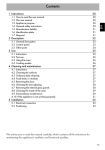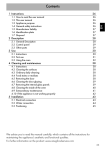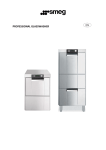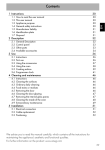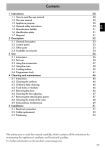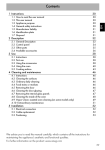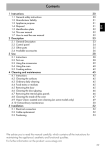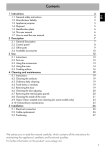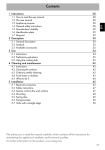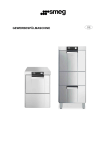Download ALFA143XM Operation Manual
Transcript
Contents 1.1 1.2 1.3 1.4 1.5 1.6 1.7 How to read the user manual This user manual Appliance purpose General safety instructions Manufacturer liability Identification plate Disposal 2 Description 2.1 General Description 2.2 Control panel 2.3 Other parts 3 Use 3.1 3.2 3.3 3.4 22 22 22 22 22 23 23 23 EN 1 Instructions 24 24 25 26 27 Instructions First use Using the oven Cooking modes 4 Cleaning and maintenance 4.1 Instructions 4.2 Cleaning the surfaces 4.3 Ordinary daily cleaning 4.4 Food stains or residues 4.5 Removing the door 4.6 Cleaning the door glazing 4.7 Removing the internal glass panels 4.8 Cleaning the inside of the oven 4.9 Extraordinary maintenance 4.10 If the appliance is not working properly 5 Installation 5.1 Electrical connection 5.2 Water connection 5.3 Positioning 27 28 28 29 30 30 30 30 30 30 31 31 32 33 34 35 35 36 37 We advise you to read this manual carefully, which contains all the instructions for maintaining the appliance's aesthetic and functional qualities. For further information on the product: www.smegfoodservice.com 21 Instructions 1 Instructions 1.1 How to read the user manual This user manual uses the following reading conventions: Instructions General information on this user manual, on safety and final disposal. Description Description of the appliance and its accessories. Use Information on the use of the appliance and its accessories, cooking advice. Cleaning and maintenance Information for proper cleaning and maintenance of the appliance. Installation Information for the qualified technician: installation, operation and inspection. Safety instructions Information Advice 1. Use instruction sequence. • Single use instruction. 22 1.2 This user manual This user manual is an integral part of the appliance and must therefore be kept in its entirety and in an accessible place for the whole working life of the appliance. 1.3 Appliance purpose This appliance is intended for cooking food in the professional environment. Every other use is considered improper. This appliance must not be used by people (including children) of reduced physical and mental capacity, or lacking in experience in the use of electrical appliances, unless they are supervised or instructed by adults who are responsible for their safety. 1.4 General safety instructions For your safety and to avoid damage to the appliance, always respect the general safety instructions indicated below. In general • Have qualified personnel carry out installation and assistance interventions according to the standards in force. • Read this user manual carefully before using the appliance. • Do not modify this appliance. • Do not try to repair the appliance yourself or without the intervention of a qualified technician. • If the power supply cable is damaged, contact technical support immediately and they will replace it. For this appliance • Do not obstruct ventilation openings and heat dispersal slots. • Do not insert pointed metal objects (cutlery or utensils) into the slots in the appliance. • Do not rest any weight or sit on the open door of the appliance. • Take care that no objects are stuck in the doors. • Do not use the appliance to heat rooms for any reason. 1.5 Manufacturer liability The manufacturer declines all liability for damage to persons or property caused by: • use of the appliance other than the one envisaged, • non-observance of the user manual provisions, • tampering with any part of the appliance, • use of non-original spare parts. 1.6 Identification plate The identification plate bears the technical data, serial number and brand name of the appliance. Do not remove the identification plate for any reason. 1.7 Disposal This appliance must be disposed of separately from other waste (Directives 2002/95/EC, 2002/ 96/EC, 2003/108/EC). The appliance does not contain substances in quantities sufficient to be considered hazardous to health and the environment, in accordance with current European directives. To dispose of the appliance: • Remove the doors and leave the accessories (racks and trays) in their usual working positions, so that children cannot get stuck in the oven compartment. • Cut the power supply cable and remove it along with the plug. Power voltage Danger of electrocution • Disconnect the main power supply. • Disconnect the power cable from the electrical system. • Consign the appliance to the appropriate selective collection centres for electrical and electronic equipment waste, or deliver it back to the retailer when purchasing an equivalent product, on a one for one basis. Our appliances are packed in nonpolluting and recyclable materials. • Consign the packing materials to the appropriate selective collection centres. Plastic packaging Danger of suffocation • Do not leave the packaging or any part of it unattended. • Do not let children play with the packaging plastic bags. 23 EN Instructions Description 2 Description 2.1 General Description Basic model Model with grill heating element and humidification system 1 Control panel 2 Oven light 3 Seal 4 Door 5 Oven fan 24 6 Rack/tray support frames 7 Steam inlet pipe 8 Grill heating element Frame shelf Description EN 2.2 Control panel Basic model Model with grill heating element and humidification system Temperature/function knob (1) Timer indicator light (4) This knob allows you to select the cooking temperature. Turn the knob clockwise to the required value, between the minimum and maximum settings. The grill function can be activated on some models only. When off, it indicates the beginning of timed cooking. When on, it indicates that timed cooking has finished. Thermostat indicator light (2) When the indicator light is fixed, it indicates that the oven is heating up to reach the set temperature. Once the temperature has been reached, the indicator light comes on and goes off to indicate that the temperature is being kept constant. Timer knob (5) This knob allows you to select manual or timed cooking. Turn the knob to symbol for manual cooking or to the numbers to select the minutes of cooking. Once the countdown has finished, the knob will automatically return to the “0” position, the oven switches off and a beep sounds to indicate the end of cooking. FAST key (3) It adjusts the maximum absorbed power. If it is pressed, the appliance will use 6.7 kW (maximum power), if it is not pressed it will use 4.5 kW (minimum power). 25 Description Humidification button (6) Safety thermostat Press this button to activate the steam supply that stays active until the button is released. The appliance is equipped with a safety device that triggers in case of serious malfunction. To re-arm the safety device press the button on the back. Steam will be dispensed if there is an adequate temperature inside the oven. Set the temperature knob to a temperature higher than 150°C. 2.3 Other parts Shelves The appliance features shelves for positioning trays and racks at different heights. The insertion heights are indicated from the bottom upwards (see 2.1 General Description). Internal ventilation The counter rotating fan(s) deactivate automatically when the door is opened and resume operation when the door is closed. Interior lighting The oven interior lighting comes on when the door (depending on the model) is opened or any function is selected. 26 Contact technical support immediately after the safety device has triggered to check if there are any faults. Use 3.1 Instructions High temperature inside the oven during use Danger of burns • Keep the oven door closed during cooking. • Protect your hands wearing heat resistant gloves when moving food inside the oven. • Do not touch the heating elements inside the oven. • Do not pour water directly onto very hot trays. • Do not allow children to get near the oven when it is in operation. • If you need to move food or at the end of cooking, open the door 5 cm for a few seconds, let the steam come out, then open it fully. High temperature inside the oven during use Danger of fire or explosion • Do not spray any spray products near the oven. • Do not use or leave flammable materials near the oven. • Do not use plastic kitchenware or containers when cooking food. • Do not put sealed tins or containers in the oven. • Do not leave the oven unattended during cooking operations where fats or oils could be released. • Remove from the oven compartment all trays and racks not used during cooking. Improper use Risk of damage to enamelled surfaces • Do not cover the bottom of the cooking compartment with aluminium or tin foil sheets. • If you wish to use greaseproof paper, place it so that it will not interfere with the hot air circulation inside the oven. • Do not place pans or trays directly on the bottom of the cooking compartment. • Do not pour water directly onto very hot trays. 27 EN 3 Use Use Improper use Risk of damages to the appliance • The hardness of the water used for humidified cooking must not exceed 1011°F. Use tap water that has been treated with a water purification or softening system. 3.2 First use 1. Remove any protective film from the outside or inside of the appliance, including accessories. 2. Remove any labels (apart from the technical data plate) from the accessories and from the cooking compartment. 3. Remove and wash all the appliance accessories (if fitted) (see 4 Cleaning and maintenance). 4. Heat the empty oven at the maximum temperature to burn off any residues left by the manufacturing process. 3.3 Using the oven The oven is designed for a maximum load of 3.5 kg. Switching the oven on To switch the oven on: 1. Select the cooking temperature and function using the temperature knob. 2. Select the cooking time or set manual cooking using the timer knob. 28 3.4 Cooking modes Defrosting The movement of air at room temperature causes frozen food to defrost quickly. This type of rapid defrosting is ideal as the taste and appearance of the de-frozen food, whether previously deep-frozen or frozen in the freezer, remain unaltered. Normal cooking Using the fan and the circular heating elements (incorporated in the rear of the oven) allows you to cook different foods on several levels. Hot air circulation ensures instant and uniform distribution of heat. Humidified cooking (on some models only) Oven humidification does not take place at temperatures lower than 150°C: lower temperatures cause condensation and dripping. Therefore, turn the thermostat knob to a value higher than 150°C and wait until the (orange) thermostat indicator light switches off before starting the oven humidification cycle. Grilling (on some models only) The heat coming from the grill heating element gives perfect grilling results above all for thin and medium thickness meat and allows you to give the food an even browning at the end of the cooking (use the 3rd or 4th shelf). Permits rapid browning of foods. The tray should be placed on the upper runner. For short-term cooking of small quantities of food, place the rack in the third runner from the bottom. For long-term cooking and grilling, put the rack in the lowest runner in accordance with the size of the pieces. The grill function is set at a grilling temperature of approximately 290°C. This temperature cannot be changed by the user. Grilling can only take place with the oven door closed: opening the door deactivates the heating elements. Each time press the humidification key for a maximum of 3 seconds. 29 EN Use Cleaning and maintenance 4 Cleaning and maintenance 4.1 Instructions Improper use Risk of damage to surfaces • Do not use steam jets for cleaning the appliance. • Do not use cleaning products containing chlorine, ammonia or bleach on steel parts or parts with metallic finishes on the surface (e.g. anodizing, nickel- or chromium-plating). • Do not use abrasive or corrosive detergents on glass parts (e.g. powder products, stain removers and metallic sponges). • Do not use rough or abrasive materials or sharp metal scrapers. 4.2 Cleaning the surfaces To keep the surfaces in good condition, they should be cleaned regularly after use. Let them cool first. 4.3 Ordinary daily cleaning Always use only specific products that do not contain abrasives or chlorine-based acids. Pour the product onto a damp cloth and wipe the surface, rinse thoroughly and dry with a soft cloth or a microfibre cloth. 4.4 Food stains or residues Do not use metallic sponges or sharp scrapers as they will damage the surfaces. Use ordinary non-abrasive products with the aid of wooden or plastic utensils if necessary. Rinse thoroughly and dry with a soft cloth or a microfibre cloth. 30 4.5 Removing the door For easier cleaning, the door can be removed and placed on a canvas. To remove the door proceed as follows: 1. Open the door completely and insert two pins into the holes on the hinges indicated in the figure. 2. Grasp the door on both sides with both hands, lift it forming an angle of around 30° and remove it. Cleaning and maintenance 3. To reassemble the door, put the hinges in the relevant slots in the oven, making sure that grooved sections A are resting completely in the slots. Lower the door and once it is in place remove the pins from the holes in the hinges. For easier cleaning the door internal glass panels can be disassembled. 1. Remove the internal glass panel by pulling the rear part gently upwards, following the movement indicated by the arrows (1). 2. Then, pull the front part upwards (2). In this way, the 4 pins attached to the glass detach from their housings in the oven door. 3. Clean the external glass panel and the panels previously removed. Use absorbent kitchen roll. In case of stubborn dirt, wash with a damp sponge and neutral detergent. 4.6 Cleaning the door glazing The glass in the door should always be kept thoroughly clean. Use absorbent kitchen roll. In case of stubborn dirt, wash with a damp sponge and an ordinary detergent. We recommend the use of cleaning products distributed by the manufacturer. 4. Reposition the internal glass panel. Take care to centre and insert the 4 pins into 31 EN 4.7 Removing the internal glass panels Cleaning and maintenance their housings in the oven door by applying slight pressure. 4.8 Cleaning the inside of the oven For the best oven upkeep, clean it regularly after having allowed it to cool. To remove the guide frames, pull the frame upwards to unhook it from its groove, then slide it out of the seats at the back. The oven should be operated at the maximum temperature for about 15-20 minutes after the use of specific products, to burn off the residues left inside the oven. For easier cleaning, remove the door. Removing racks/trays support frames Removing the guide frames enables the sides to be cleaned more easily. unscrew the fastening pins of the frame. 32 When cleaning is complete, repeat the above procedures to put the guide frames back in. 4.9 Extraordinary maintenance Live parts Danger of electrocution • Disconnect the oven power supply. 6. Replace the cover correctly, so that the moulded part of the glass is facing the door. 7. Press the cover completely down so that it attaches perfectly to the bulb support. Removing the door seal Replacing the internal light bulb 1. Completely remove all accessories from inside the oven. 2. Remove the racks/trays support frames. 3. Remove the bulb cover using a tool (e.g. a screwdriver). To permit thorough cleaning of the oven, the door seal may be removed. There are fasteners on all four sides and in the middle to attach it to the edge of the oven. Pull the edges of the seal outwards, where indicated to detach it. Incandescent lamps: 4. Unscrew and remove the lamp. 5. Replace the lamp with one of the same type (25W). 33 EN Cleaning and maintenance Cleaning and maintenance 4.10 If the appliance is not working properly Problem The oven is not working Foods either take too long or too little to cook Likely solution • The timer knob is positioned on 0. • The plug is not properly inserted in the socket. • The electrical system is damaged or not working properly. • The fuses have blown or the circuit breakers have not been activated. • The temperature setting is incorrect. • The humidification key has not been pressed properly. No steam is being supplied • The oven door has not been closed properly. • The foods are being left in the oven for too Moisture forms inside the oven and on the long after cooking. Do not leave them in the foods oven for more than 15-20 minutes after the end of the cooking time. • The device controlling the supply of water inside the oven is not working properly. There is water inside the oven • The dispensing command has been activated for too long. This product meets the current safety regulations in force for electrical appliances. To prevent safety hazards for users, all technical inspections or repairs must be carried out by qualified personnel. If the appliance is not working properly, before calling Customer Service, ensure that the procedures listed below have been performed. 34 Installation 5.1 Electrical connection Power voltage Danger of electrocution • Have the electrical connection performed by authorised technical personnel. • The appliance must be connected to earth in compliance with electrical system safety standards. • Disconnect the main power supply. • Do not pull the cable to remove the plug. • Use H07RN-F cables withstanding a temperature of at least 90°C. • The tightening torque of the screws of the terminal supply wires must be 1.5 - 2 Nm. General information Check the grid characteristics against the data indicated on the plate. The identification plate bearing the technical data, serial number and brand name is visibly positioned on the appliance. Do not remove this plate for any reason. Perform the ground connection using a wire that is 20 mm longer than the other wires. The appliance is provided with a five-core H07RN-F cable (5 x 1.5 mm² referring to the cross section of the internal conductor). Connection modes: • 220-240 V 1N~ Use a 3 x 4 mm² three-core cable. • 380-415 V 2N~ The terminal indicated by symbol links up parts that are normally earthed. Connect the appliances appropriately using this terminal in order to make sure that they are equipotential. If the phase voltage drops below 190V~, the performance of the oven may suffer, not due to the product itself. Use a 4 x 2.5 mm² four-core cable. • 380-415 V 3N~ Use a 5 x 1.5 mm² five-core cable. The values indicated above refer to the cross-section of the internal conductor. 35 EN 5 Installation Installation Fixed connection Fit the power line with an omnipolar circuit breaker in compliance with installation regulations. The circuit breaker should be located near the appliance and in an easily reachable position. Connection with plug and socket Make sure that the plug and socket are of the same type. Avoid using adapters and shunts as these could cause overheating and a risk of burns. Cable replacement Power voltage Danger of electrocution • Disconnect the main power supply. 1. Unscrew the rear casing screws and remove the casing to access the terminal board. 2. Replace the cable. 3. Make sure that the cables follow the best route in order to avoid any contact with the appliance. 36 5.2 Water connection Improper use Risk of damages to the appliance • If the water pipe is new or has not been used for a long time, before making the connection, let the water flow to ensure that it is clear and free from impurities. • The inlet pressure should be between 50 kPa min. and 500 kPa max. Connect the water inlet socket on the back of the appliance to a water socket with a threaded ¾” opening. Installation Heavy appliance Danger of crush injuries • Position the appliance with the aid of a second person. Steam outlet pipe Depending on the model, there are two exhaust flues on the back of the appliance for releasing the steam produced during cooking. These must be left free of any obstruction. Avoid crushing them. Pressure on the open door Risk of damages to the appliance • Never use the open door to lever the appliance into place when fitting. • Avoid exerting too much pressure on the oven door when open. Heat production during appliance operation Risk of fire • Veneers, adhesives or plastic coatings on adjacent furniture should be temperature-resistant (no less than 90°C). Improper installation Risk of injury • The appliance support base should not exceed a height of 160 mm from the floor. Levelling Level the appliance on the ground using the adjustable feet. The foot has a range of 10 mm. 37 EN 5.3 Positioning Installation Distances Improper installation Risk of damages to the appliance • The appliances cannot be installed one on top of the other without installing the stack kit (on demand). Place the appliance at a distance of at least 50 mm from any back wall and at 30 mm from any side wall. Keep a minimum distance of 50 mm between the appliances in the case of installation of multiple and adjacent appliances. 38


















